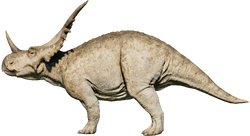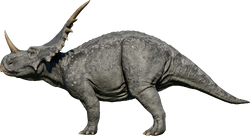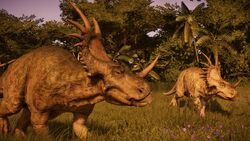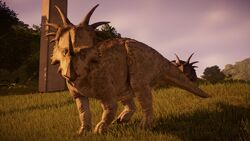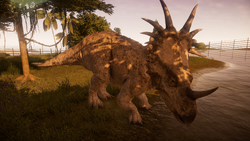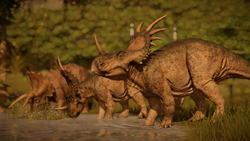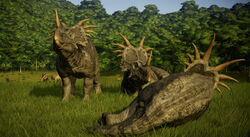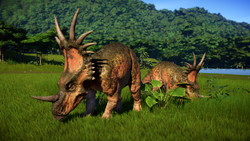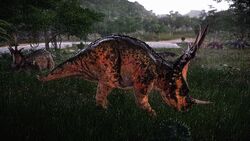Template:Era Template:Dinosaur Infobox
| What you have there is a Styracosaurus, or 'spiked lizard'. The reason for the name should be obvious. |
Styracosaurus is a genus of ceratopsid dinosaur that originated from Late Cretaceous North America. Styracosaurus fossils are first unlocked on Isla Muerta through Entertainment Division objectives where they can then be excavated in the Dinosaur Park Formation and Laramie Formation.
The Styracosaurus was first added to the game with the Deluxe Dinosaur Pack.
History
Styracosaurus was not planned to be a featured dinosaur in the original Jurassic Park on Isla Nublar, and no populations were reported by InGen on either Nublar or their Site B facility on Isla Sorna in 1996.[1] The species appears to have been present in Jurassic World on Isla Nublar and, as of 2018, it has been revealed that the island's Styracosaurus population was the victim of an unconfirmed form of cruelty.[2] It is unknown if there are any surviving populations.[3]
Description
The Styracosaurus is a medium-sized ceratopsian. The dinosaur's base cosmetic genome is a lightish-brown, with dark green stripes on its back, head, and tail along with some orange on its' frill.
Unlocked in the early to mid-game, Styracosaurus is similar to other early game ceratopsians such as Sinoceratops in terms of requirements with a modest grassland requirement and negligible forest needs.
Behavior
Like all other ceratopsians, Styracosaurus will engage in a death duel with large and medium carnivores such as Tyrannosaurus and Albertosaurus if provoked.
A social animal, Styracosaurus must forms pairs or small herds between two and five individuals to satisfy its comfort requirements. They can tolerate a fair number of other dinosaurs, making it ideal to mix them with other ceratopsians or unrelated species. Additionally, Styracosaurus is capable of living somewhat peacefully alongside small carnivores such as Deinonychus and Dilophosaurus, only occasionally engaging in non-fatal territorial fights.
Styracosaurus will, as all herbivores do, socialize with others of its own species on occasion.
Paleontology
Styracosaurus was discovered in Alberta, Canada in 1913 by Lawrence Lambe. Today, Styracosaurus fossils are found in the rich Dinosaur Park Formation in Alberta. There were once many species of Styracosaurus found throughout eastern North America from Montana to Canada, but many have now been assigned to new genera such as Rubeosaurus and Einiosaurus.
Along with Sinoceratops, they are part of the centrosaurine branch of ceratopsids which are categorized by their nose-horn being larger than their brow horns. Styracosaurus also had common features to those found in all ceratopsians; a beaked mouth with powerful molars for grinding down plant matter and cheek pouches to store food for chewing. It is currently unclear whether their frills are merely features of display or if they served as a form of protection against predators, though the latter is generally considered more likely because the smaller stature of the Styracosaurus would have made it vulnerable to larger predators.
Paleoecology
Styracosaurus lived alongside other dinosaurs such as the hadrosaurs Parasaurolophus, Corythosaurus, and Lambeosaurus, the armoured Euoplocephalus and Edmontonia, other ceratopsians such as Centrosaurus and Chasmosaurus, as well as the tyrannosaurs Gorgosaurus and Albertosaurus. Like many other ceratopsians of its time, it lived along the western interior seaway.
Available genomes
| Fossil icon | Dig site | Quality | Number available |
|---|---|---|---|
| Dinosaur Park Formation | 1 3 6 4 | ||
| Laramie Formation | 1 3 6 4 |
Skins
Trivia
- Styracosaurus appeared in Jurassic Park: Operation Genesis, considered by many to be Jurassic World Evolution's spiritual predecessor.
Template:Clr
Gallery
References
- ↑ http://www.dinosaurprotectiongroup.com/what-killed-the-gene-guard-act.html Dinosaur Protection Group - What Killed the Gene Guard Act
- ↑ http://www.dinosaurprotectiongroup.com/images/posters/cruelty.jpg
- ↑ https://twitter.com/Jack_Ewins/status/1052300874163376129
External links
- Styracosaurus on Wikipedia
- Jurassic Park: Operation Genesis on Wikipedia
Template:JWEDinosaurs


